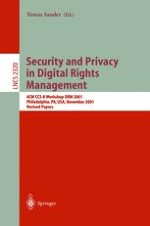The ACM Workshop on Security and Privacy in Digital Rights Management is the ?rst scienti?c workshop with refereed proceedings devoted solely to this topic. The workshop was held in conjunction with the Eighth ACM Conference on Computer and Communications Security (CCS-8) in Philadelphia, USA on November 5, 2001. Digital Rights Management technology is meant to provide end-to-end so- tions for the digital distribution of electronic goods. Sound security and privacy features are among the key requirements for such systems. Fifty papers were submitted to the workshop, quite a success for a ?rst-time workshop. From these 50 submissions, the program committee selected 15 papers for presentation at the workshop. They cover a broad area of relevant techniques, including cryptography, system architecture, and cryptanalysis of existing DRM systems. Three accepted papers are about software tamper resistance, an area about which few scienti?c articles have been published before. Another paper addresses renewability of security measures. Renewability is another important security technique for DRM systems, and I hope we will see more publications about this in the future. I am particularly glad that three papers cover economic and legal aspects of digital distribution of electronic goods. Technical security measures do not exist in a vacuum and their e?ectiveness interacts in a number of ways with the environment for legal enforcement. Deploying security and an- piracy measures adequately requires furthermore a good understanding of the business models that they are designed to support.
